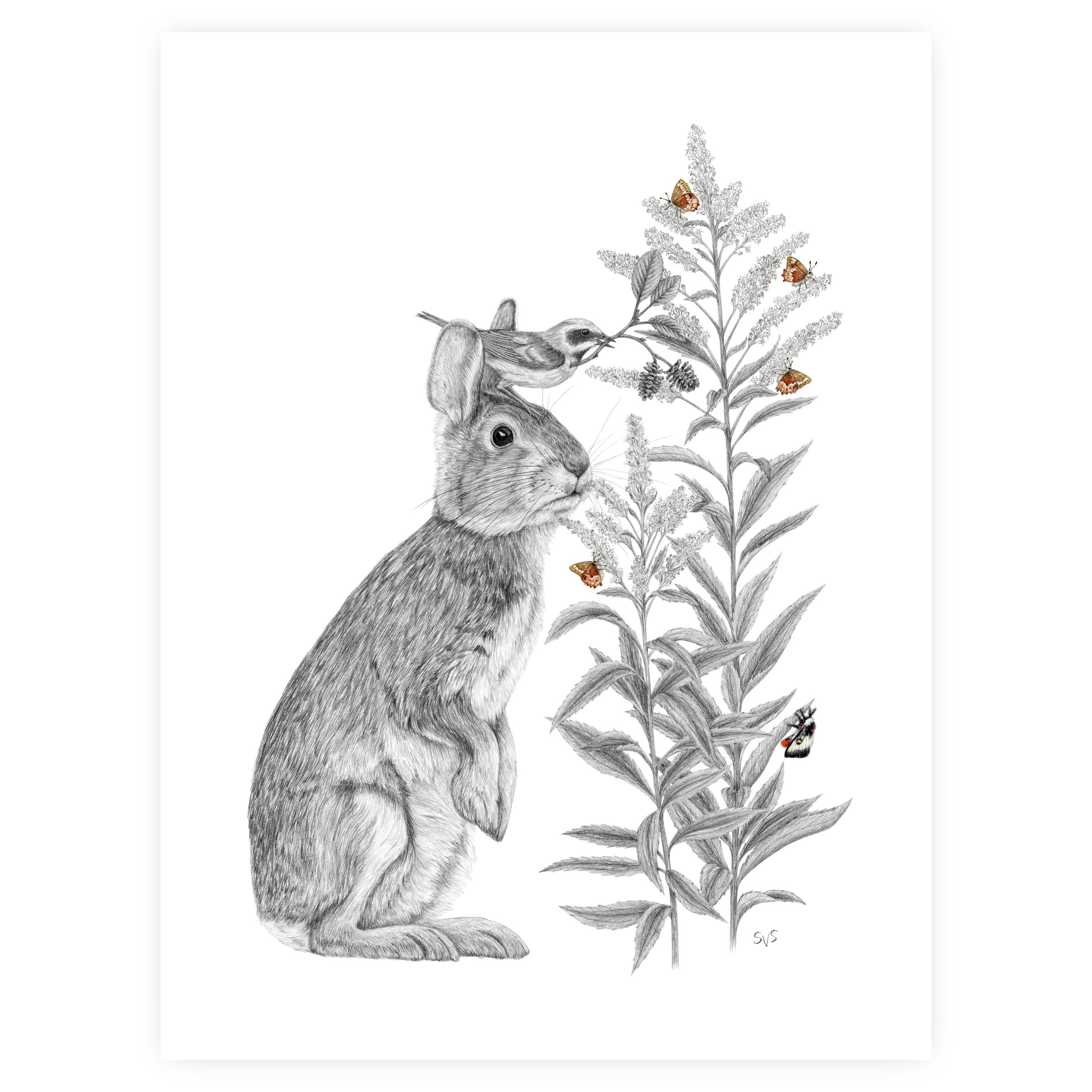 Image 1 of
Image 1 of


New England Cottontail (Print)
The New England cottontail (Sylvilagus transitionalis) is an at-risk species of rabbit that lives within early successional forest habitat on the east coast. In this piece, a New England cottontail reaches up on hind legs to sniff Canada goldenrod (Solidago canadensis). A preferred food for the cottontail, Canada goldenrod is also one of many flowers that is pollinated by the frosted elfin butterfly (Callophrys irus). This butterfly, along with the illustrated New England buckmoth (Hemileuca lucina) and the golden-winged warbler (Vermivora chrysoptera), all rely on young forest habitats during some if not all of their stages of life. The at-risk golden-winged warbler holds a small branch of smooth alder (Alnus serrulata) in its beak. Alder thickets provide particularly good habitat for New England cottontails, and also serve as a common food source for them.
Original: graphite, watercolor, & colored pencil on paper.
150 limited edition
12” x 16”
Archival hand-signed print
Digitally printed on Hahnemuhle bamboo fine art paper - natural
The New England cottontail (Sylvilagus transitionalis) is an at-risk species of rabbit that lives within early successional forest habitat on the east coast. In this piece, a New England cottontail reaches up on hind legs to sniff Canada goldenrod (Solidago canadensis). A preferred food for the cottontail, Canada goldenrod is also one of many flowers that is pollinated by the frosted elfin butterfly (Callophrys irus). This butterfly, along with the illustrated New England buckmoth (Hemileuca lucina) and the golden-winged warbler (Vermivora chrysoptera), all rely on young forest habitats during some if not all of their stages of life. The at-risk golden-winged warbler holds a small branch of smooth alder (Alnus serrulata) in its beak. Alder thickets provide particularly good habitat for New England cottontails, and also serve as a common food source for them.
Original: graphite, watercolor, & colored pencil on paper.
150 limited edition
12” x 16”
Archival hand-signed print
Digitally printed on Hahnemuhle bamboo fine art paper - natural
The New England cottontail (Sylvilagus transitionalis) is an at-risk species of rabbit that lives within early successional forest habitat on the east coast. In this piece, a New England cottontail reaches up on hind legs to sniff Canada goldenrod (Solidago canadensis). A preferred food for the cottontail, Canada goldenrod is also one of many flowers that is pollinated by the frosted elfin butterfly (Callophrys irus). This butterfly, along with the illustrated New England buckmoth (Hemileuca lucina) and the golden-winged warbler (Vermivora chrysoptera), all rely on young forest habitats during some if not all of their stages of life. The at-risk golden-winged warbler holds a small branch of smooth alder (Alnus serrulata) in its beak. Alder thickets provide particularly good habitat for New England cottontails, and also serve as a common food source for them.
Original: graphite, watercolor, & colored pencil on paper.
150 limited edition
12” x 16”
Archival hand-signed print
Digitally printed on Hahnemuhle bamboo fine art paper - natural